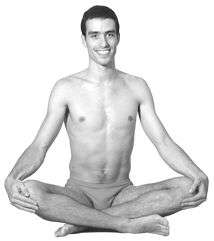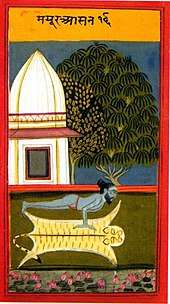Sukhasana
Sukhasana (Sanskrit: सुखासन; IAST: Sukhāsana), easy pose,[1][2][3][4] is a simple cross-legged sitting asana in hatha yoga, sometimes used for meditation in both Buddhism and Hinduism.

Etymology
The name comes from the Sanskrit words सुख sukha, "pleasure",[5] and आसन āsana, "posture" or "seat".[6]
The 19th century Sritattvanidhi describes and illustrates the pose.[7] The name, and the more general name Yogasana which may denote a variety of similar poses, is found in much older documents as a meditation seat, such as in the 4th century Darshana Upanishad.[8]
Description
While opening the hips and lengthening the spine, the asana's relative ease on the knees makes it easier than siddhasana or padmasana for people with physical difficulties. Some schools do not consider it to be as effective for prolonged meditation sessions because it is easy to slump forward while sitting in it. For meditation, it is important that the spine be straight and aligned with the head and neck. But if the practitioner steadies the sukhasana pose by putting pillows or blankets under the knees to create a steadiness, it may be easier to sit longer in sukhasana for meditation without slumping forward. An additional blanket or pillow under the buttocks may also be beneficial and steadying.[9] The 20th century Jnana Yoga guru Ramana Maharshi advocated it as suitable for attaining Enlightenment.[10]
See also
References
- "Easy Pose". Yoga Journal. Retrieved 2011-04-11.
- Saraswati, Satyananda (1974). Meditations from the Tantras, with live class transcriptions. Bihar School of Yoga. p. 94.
- Institute Of Naturopathy Staff (2003). Speaking Of Yoga For Health. Sterling Publishers. p. 56. ISBN 978-1-84557-026-2.
- Feuerstein, Georg; Payne, Larry (5 April 2010). Yoga For Dummies. For Dummies. p. 200. ISBN 978-0-470-50202-0.
- Joshi, K. S. (1991). Yogic Pranayama: Breathing for Long and Good Health. Orient Paperbacks. p. 45. ISBN 978-81-222-0089-8.
- Sinha, S. C. (1996). Dictionary of Philosophy. Anmol Publications. p. 18. ISBN 978-81-7041-293-9.
- Sjoman, Norman E. (1999) [1996]. The Yoga Tradition of the Mysore Palace (2nd ed.). Abhinav Publications. pp. 80, 89, 96. ISBN 81-7017-389-2.
- Larson, Gerald James; Bhattacharya, Ram Shankar (2008). Yoga : India's Philosophy of Meditation. Motilal Banarsidass. pp. 479, 599. ISBN 978-81-208-3349-4.
- Rama, Swami, Meditation and its Practice, Himalayan Institute, 1992
- Maharsi, Ramana (1962). The teachings of Bhagavan Sri Ramana Maharshi in his own words. Rider. p. 134.
Further reading
- Iyengar, B. K. S. (1 October 2005). Illustrated Light On Yoga. HarperCollins. ISBN 978-81-7223-606-9.
- Saraswati, Swami Satyananda (1 August 2003). Asana Pranayama Mudra Bandha. Nesma Books India. ISBN 978-81-86336-14-4.
- Saraswati, Swami Satyananda (January 2004). A Systematic Course in the Ancient Tantric Techniques of Yoga and Kriya. Nesma Books India. ISBN 978-81-85787-08-4.
_from_Jogapradipika_1830_(detail).jpg)

